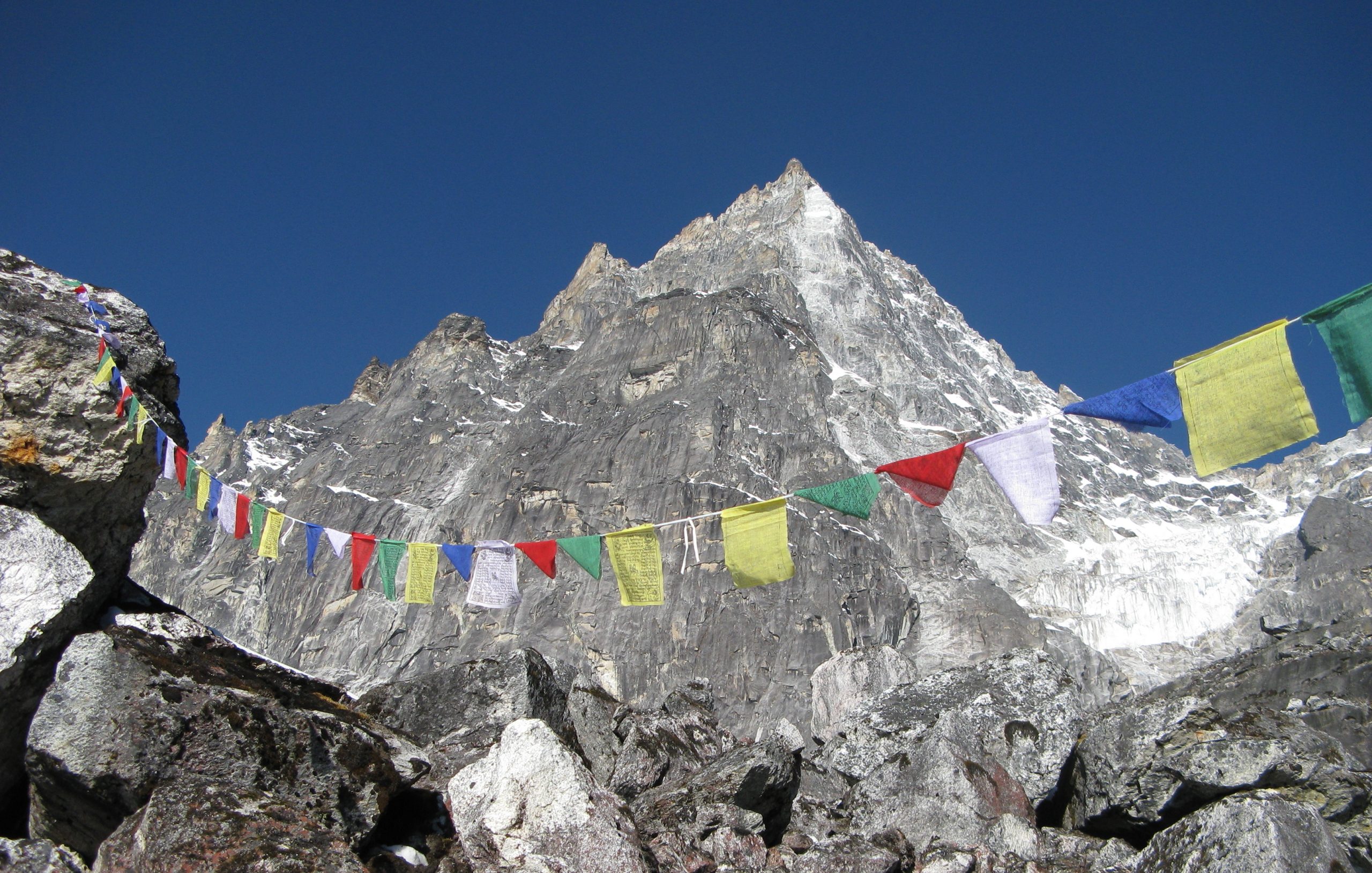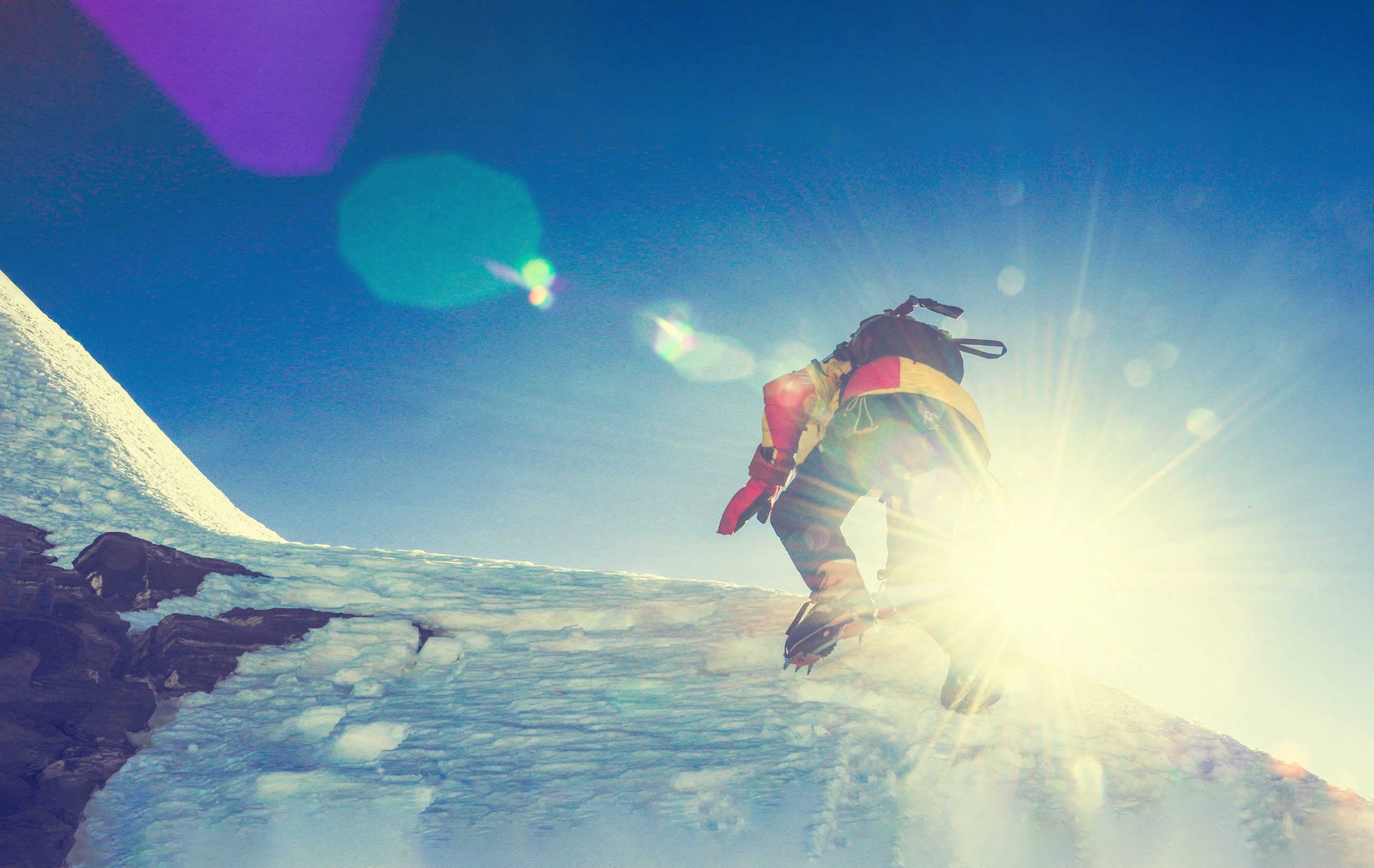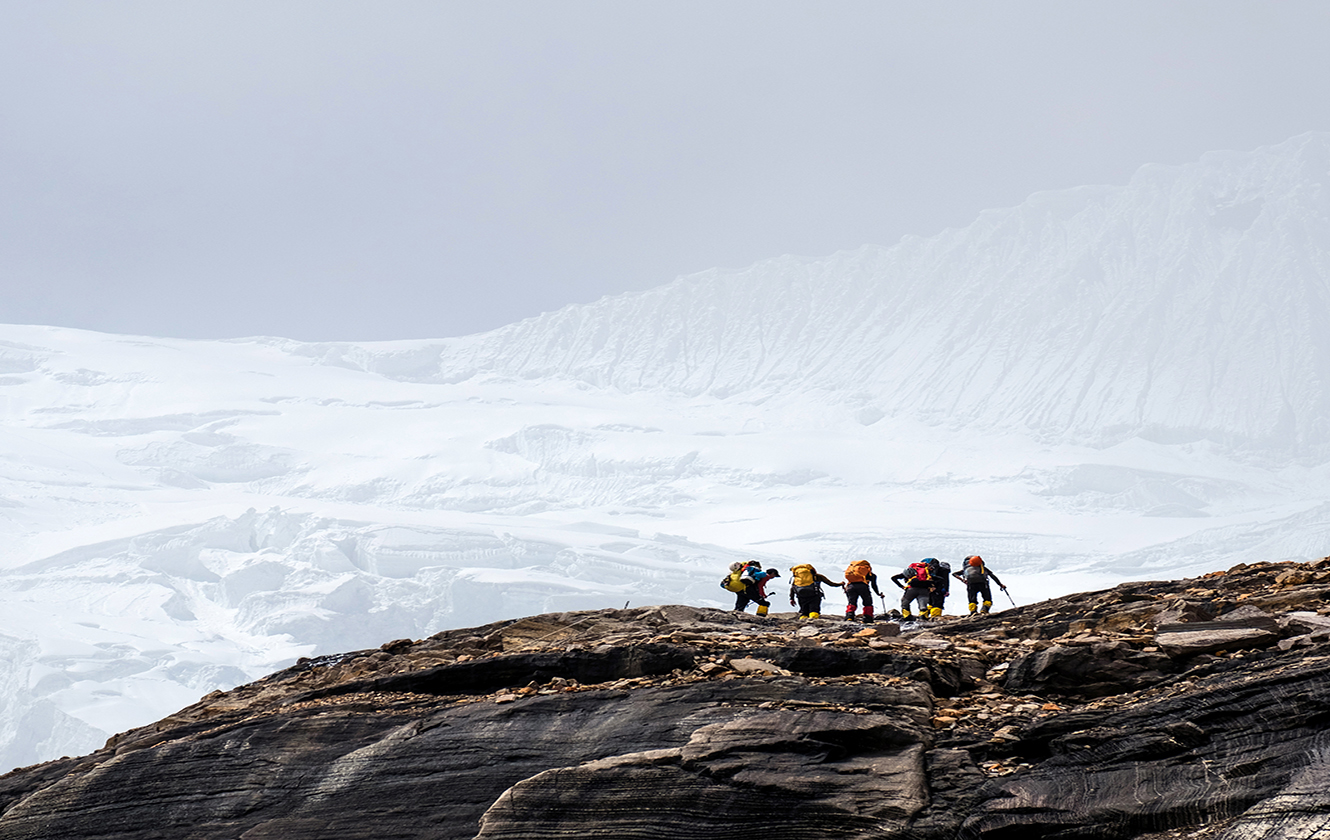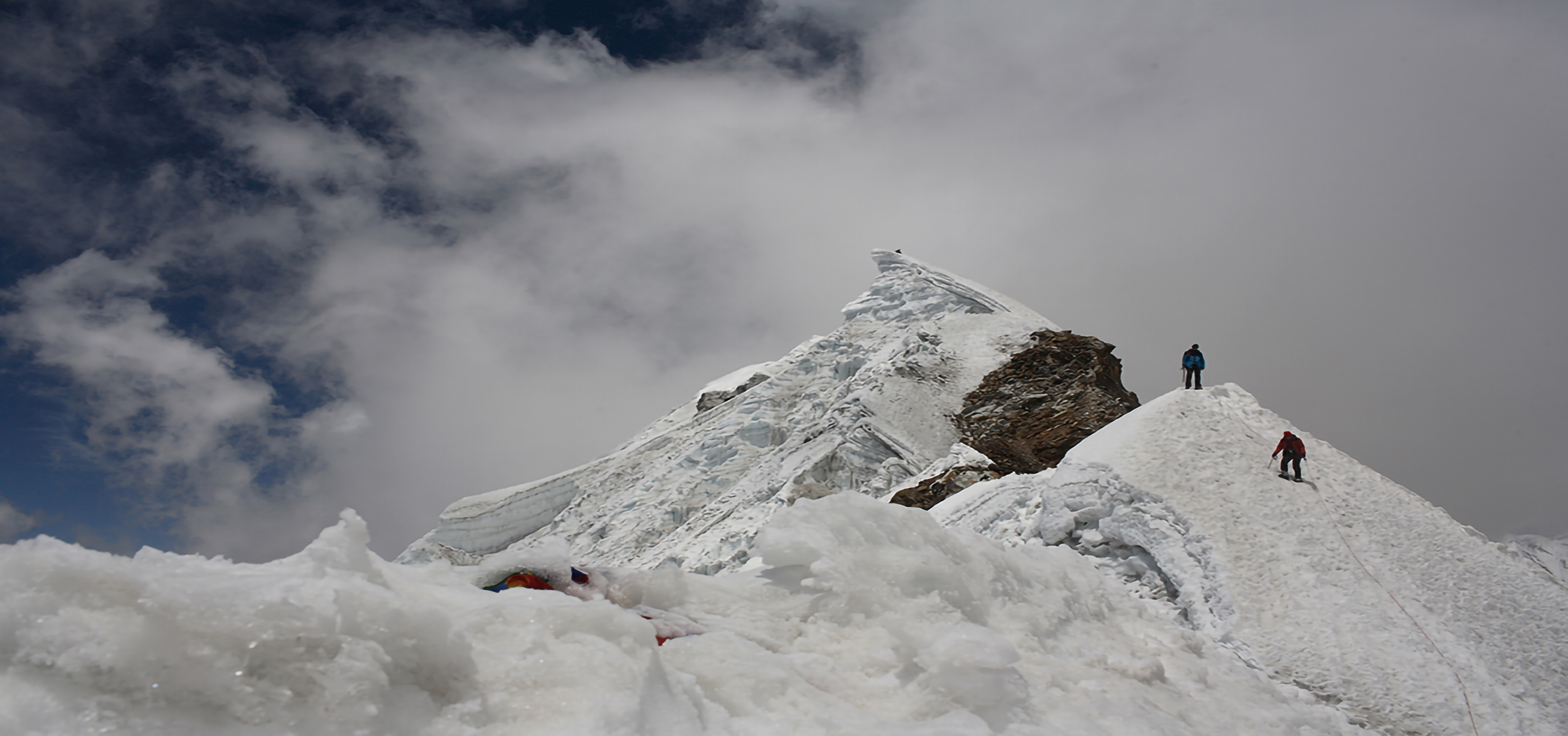
Ama Dablam Expedition
- Home /
- Nepal /
- Peak Climbing & Expeditions /
- Ama Dablam Expedition
SOUTH WEST RIDGE OF AMA DABLAM
Towering over Tengboche monastery and the Sherpa village of Pangboche at a height of 6,856m, Ama Dablam is one of the most iconic mountains in Nepal. The much-coveted SW ridge is one of the more popular routes in the Himalayas today, with climbers often using it as preparation for an expedition to one of the greater 8,000m peaks (of course the mountain is by its own right a fantastic objective!). Comprising of steep ice and rock with exposed ridges, the technical nature of the route is somewhat lessened by the presence of fixed lines along the majority
of the route.
OUR ROUTE
We start our acclimatization when we land in Lukla, the herpa village known as the ‘Gateway to Khumbu’. We trek through numerous Sherpa villages before arriving in the grassy surrounds of Ama Dablam Base Camp, which is undoubtedly one of the more scenic base camps in the Himalayas. Above the base camp we place three camps on the mountain, each precariously positioned on the ridge, which means you’ll need to have a good head for heights. Our summit push will begin early in the morning from Camp 3 and hopefully you’ll top out in great weather, as the summit affords spectacular views of numerous Himalayan giants, including Mount Everest, Lhotse and Nuptse. This month-long expedition is suited to strong rock climbers and technically-orientated mountaineers, who have previous experience in the Himalayas or other lower technical peaks in Europe, North and South America.
TECHNICAL GRADING
This expedition requires previous climbing experience in the Himalayas. Excellent fitness is essential as most climbing days are 8-12 hrs. along a technical route carrying a 10~15 kgs pack. The South West Ridge route is technical and will reach a maximum altitude of 6856m.
HIGHLIGHTS
- Stunning views of Everest, Lhotse, Nuptse, Makalu and Cho Oyu
- Summit one of the jewels of the Khumbu valley
- Experience technical climbing under well protected conditions
- Colourful Buddhist culture
- Spirited Sherpa People
Itinerary In Detail
-
Day 01: Arrival in Kathmandu (1,400 m / 4,592 ft.)
Upon arrival in Katmandu’s Tribhuvan International Airport, meet, assist and transfer to hotel. After welcome refreshments and room check in the hotel, there will be a short briefing and orientation about the trip. Rest of the day is free for leisure.
Overnight at hotel.
-
Day 02: Expedition preparation day.
Day is free for the last-minute preparations, before we head to Mountain.
Overnight at hotel.
-
Day 03: Fly to Lukla & start Trek to Phakding (2,652m / 8,700 ft.) – 3 hrs.
Early morning transfer to the airport to fly to Lukla (2880m). This 45-minute flight provides a magnificent entry to the trek. It highlights the snowline of the Himalayan Range in the north and the rugged landing at the Lukla airport, which is said to be one of the most spectacular flights in the world. Upon arrival the guide will arrange the porters at the nearby lodge. During this break, the guests are welcome to explore this bustling town on top of a hill with rows of houses, hotels and shops lining both sides of the traditional cobbled street.
The trek starts by following the trail leading to the northwest direction through the narrow street, which immediately descends from the end of the village on a trail through the open hillside. The trail is well defined and there are many shops and lodges catering to the trekkers. This day’s trek is an easy one and ultimately descends to the river at Phakding (2,652m).
Dinner and overnight at teahouse lodge.
-
Day 04: Trek to Namche Bazaar (3,447m / 11,300 ft) – 5~6 Hrs
Leave the main village and the follow the trail on the left bank of the Dudh Kosi River. It is a pleasant walk for the first half of the day as one passes through agricultural countryside and small wayside villages. Just before lunch, there is a steep climb of about 20 minutes to arrive at Monjo for Lunch. After lunch, trek up to the check post to check the permits and enter into the Sagarmatha National Park. Descend for 10 minute and then cross a suspension bridge to arrive at Jorsale (2,800m). Pass through several small villages and beautiful pine forest. This is a busy trail with plenty of human interest.
Our first good views are of west ridge of Kusum Kangru (6,339m). Follow the Dudh Kosi River, crossing a rickety suspension bridge, which is in a dilapidated condition, and then slowly climb up a very steep trail to Namche Bazaar. Near half waypoint, we enjoy our first views of Mt. Everest (8,848m), Nuptse (7,879m) and Lhotse (8,383m) – the big three. The climb is for nearly 3 hours as one gain in altitude making breathing difficult due to rarified air. Arrive at a gate with a sign saying, “Welcome to Namche Bazaar” but it is very misleading as it takes another 20 minutes to arrive at the main town.
This prosperous town is the largest in Khumbu. Mt. Thamserku (6,648 m) and Kwangde Ri (6,624 m) loom along the east and west of the village. The sacred mountain Khumbila (5,707 m) dominates the skyline along the west.
Dinner and overnight at teahouse lodge.
-
Day 05: Rest & acclimatization Hike to Shyangboche Everest View Hotel (3,880 m / 12,727 ft.) - 3/4 hours.
After breakfast start climb to famed Hotel Everest View hotel in Shyangboche at an altitude of 3,880m. It is a steep climb through the rocky train until we reach to Shyangboche Airstrip. From here is it fairly gentle climb mostly through Rhododendron, Pine and Juniper forest. As we slowly gain the altitude we can experience dramatic changes in the vegetation.
Once we reach to the summit of Shyangboche we can witness the breathtaking view giant snowcapped Mountains including Mt. Everest (8,848m), Lhotse (8,516m), Thamserku (6,648 m), Kwangde Ri (6,624 m), Khumbela (5,761 m) & beautiful Mt. Amadablam (6,812 m) any many others.
From here it is a level walk to famed Everest View Hotel. Along the way we can see many Yaks grazing around. We will spend good time at Hotel Everest View having Tea / Coffee while enjoying the panoramic view snowcapped Mountain. Later start descends down to Namche Bazaar for lunch. In the afternoon you are free for a rest or stroll around colorful Namche Bazaar. There are several coffee shops, bakery, book shops and adventure gears shops etc.
Dinner and overnight at teahouse lodge.
-
Day 06: Trek to Thyangboche Monastery (3,840 m / 12,595 ft) – 7 Hrs.
Walk to the checkpoint to show the permits. Then walk uphill for a short period to reach a huge prayer stone from where the path straightens and we get great views of some of the Himalayan ranges. Later as we walk we descend through the rhododendron forest, watching for the blood pheasant and Imphayan pheasant in the undergrowth. As we reach the valley there is Dudh Kosi River where we stop for a lunch at Phunki Thanga (3,200m), next to several large water driven prayer wheels. The afternoon is spent climbing slowly on a steep trail to the Thyangboche Monastery. Thyangboche lies at the base of Kangtega and is a classic setting with superb views backs up the valley to the Ama Dablam, and the Everest poking its southwest face over the huge ridgeline linking Nuptse and Lhotse. The Thyangboche Monastery is one of the most important monasteries of the Khumbu Region and the late afternoon can be spent visiting this ancient Monastery. It is the traditional place where all Everest Expeditions receive their blessings as they walk in towards the base camp. After visiting Thyangboche Monastery a short, steep and muddy descent to Devouche through theforest of briches, conifers and rhododendrons.
Dinner and overnight at teahouse lodge.
-
Day 07: Trek to Pangboche (3,985 m. /13,070 ft.) - 5 hrs.
After breakfast, set out on the trail with a short, steep and muddy descent through a forest of birch, conifer and rhododendron to the meadows of Devouche. Continue on a level trail through forests to arrive at a suspension bridge high above the fast flowing Dudh Kosi River with fine views of Mt. Amadablam. Cross the suspension bridge and climb for another 20 minutes to arrive at a resting place. Continue to climb to a pass and then there is a gentler walk to the village of Pangboche (3985m). Rest of the day is free for leisure.
Eve: Visit Pangboche Monastery which lies more on the route to Phortse and is not easily reached from the lower trail and for those who desire to visit the monastery, the trail bifurcates just before the village after the pass and a hard half hour of climb up the ridge brings one to this fabled monastery. At the monastery is housed the Scalp of the Yeti which traveled the world in the 60’s. It is a tradition that Mountaineers visit this monastery for blessings for success and safety from Lama before they begun their expedition.
Dinner and Overnight at Pangboche.
-
Day 08: Rest and acclimatization in Pangboche.
We spend a day in Pnagboche for acclitimization before we reach to Base Camp.
Dinner and Overnight at Pangboche.
-
Day 09: Trek to Base Camp (4,600 m / 15,088 ft.) – 5 hrs.
After breakfast descend down to Imja River and then walk up the ridge opposite the village. It’s a gentle ascent to this meadow base camp that sits at the foot of the mountain. With close up views of this Himalayan mastiff, it’s one of the best camp sites in the Khumbu. The Base Camp consists of a dining tent, kitchen tent, shower tent and individual comfortable tents for clients. You’ll get a good sleep on your comfortable sleeping mattress, critical for good rests after acclimatization rounds on the mountain before the summit push.
Overnight at Camp.
-
Day 10: Rest day in Ama Dablam Base Camp
We take an easy day to give your body extra time to slowly acclimatize. You may spend the day exploring the base camp grounds, taking short walks or sleeping and enjoying your base camp service. Your climbing acclimatization rounds, we will conduct a special Puja (Buddhist ceremony) with the local Lama to request the mountain spirits for safe passage. This is a highlight for many climbers.
Overnight at Camp.
-
Day 11: Training day at Base Camp
We begin the day by first checking gear before heading out for a practice session. On a setup of fixed lines, we’ll practice climbing up and traversing on fixed lines, and abseiling over knots. You should be confident using your gear whilst fully kitted up (gloves, climbing clothes). Please feel free to ask your guides if you have questions about safety and explanations about the route.
Overnight at Camp.
-
Day 12: Day trip from Base Camp to 5,800 m / 19,024 ft.
The first round of acclimatization trips on the mountain starts with a hike up to 5,800m / 19,024 ft. at the foot of the SW ridge route. We walk eastwards on a ridge around the south end of the Mingbo glacier that stretches off Ama Dablam. From the saddle, we can see Mingbo La pass further East that gives passage to the Hinku valley. We’ll hike up through a boulder field, cross a slab area and up a gully to the ridge. The SW route can be clearly seen from this advantage point to give you a better idea of the challenges and fun ahead! We return via the same route to good food and rest.
Overnight at Camp.
-
Day 13: Rest and gear preparation day
Over the next 2 days we’ll be climbing up to Camp 2 and sleeping at Camp 1, so this is the day to pack and prepare. You’ll be carrying your sleeping bag, mat and personal items. Some climbers choose to bring 2 sets of sleeping bags so that 1 is left at base camp and 1 at a higher camp. This spares you from carrying your sleeping bag constantly up and down the mountain. Climbing Sherpas will head up today to set up the camps carrying tents, food and fuel.
Overnight at Camp.
-
Day 14: Climb from Base Camp (4600m) to Camp 1 (5900m / 19,352 ft)
We follow the ridge route up through the boulder field, over the slab, up the gully and then scramble further to the tent platform, or Camp 1. You’ll be welcomed with a hot drink and will be able to rest in your tent before dinner.
Overnight at Camp.
-
Day 15: Climb to Camp 2 (6,100m / 20,008 ft.) & return to base camp.
This is the first serious day of climbing. It begins with a hike up to 2 fingers like rock projections, and a climb up to the ridge proper. It’s a narrow ridge that leads to an exposed traverse on tension fixed lines. We jumar up to the ridge again and follow this to another face traverse, that takes us to the Yellow Tower. It’s a 15m pitch around AUS 16/US 5.8/5b standard to our camp. Camp 2 is an infamous site known for its precarious location with 360o degrees of surrounding exposure. Once we’ve touched this site we drop back down to base camp.
Overnight at Camp.
-
Day 16~17: Rest and contingency days also for final Summit preparation
With our full rotation now complete and familarity of the route and its challenges established, we rest and wait for our summit push. This is time to rest and eat! We plan an extra contingency day for weather.
Overnight at Camp.
-
Day 18: Climb Camp 1 (5,900m / 19,352 ft.)
The final summit push! We follow the now familiar route up to Camp 1.
-
Day 19: Climb from to Camp 2 (6100m)
We continue on up now to Camp 2. Get a good rest and sleep. The next 2 days will be challenging and rewarding!
-
Day 20: Climb to Camp 3 (6,400m / 20,992 ft)
The climb from Camp 2 to Camp 3 is considered to be the most difficult of the entire route. We begin by dropping briefly, traverse eastwards and then ascend to the base of the Grey Tower. We climb up alongside the Grey Tower using a steep rock gully that’s approximately an 80m ascent over 3 pitches. Watch for rock fall here especially if there are other parties overhead. We cross an exposed traverse that rings us to the West side of a large snow ridge (Mushroom ridge). From here it’s a climb up on steep and narrow ridge to Camp 3.
-
Day 21: Summit Amadablam (6856m) and return back to Camp 2
Our summit push! we climb up the steep snow/ice slope behind Camp 3 and move towards the right side of the face to a small snow field. We cross a Bergschrund and climb up to an ice crest. This follows the summit ridge route to the large glorious snowfield summit top!
The central position of Ama dablam affords stunning views of Khumbu peaks and beyond from its summit. From the summit, you see the summit of Island Peak just below you, and unobstructed views of Everest and Lhotse. Further a field in other valleys, Cho Oyu and Malakhu can also be seen. After a period of celebration on the summit, we climb and abseil down to Camp 3. Pack up camp and head to Camp 2 for the night. A well-deserved rest awaits.
Overnight Camp.
-
Day 22: Descend down to Base Camp.
After a quick breakfast, we pack up Camp 2 and return to base camp. Showers and good food are waiting to welcome you “home” from your summit success.
Overnight at Camp.
-
Day 23: Rest and pack up base camp
It’s been an exhausting last few days so we take an extra day to rest and slowly begin to pack up base camp. Enjoy your last day soaking in the views from this tranquil camp site and enjoy a farewell dinner with your Sherpa team.
-
Day 24: Backtrack to Namche Bazaar.
-
Day 25: Backtrack to Lukla.
-
Day 26: Fly to Kathmandu.
-
Day 27: Contingency day.
-
Day 28: Departure from Kathmandu
Free until final departure from Kathmandu, Nepal.
28 Days From

Any Question?
Feel free to call our travel experts.
+977 9851189018, +977 9801089018
info@asiaticroads.com
28 Days From

Any Question?
Feel free to call our travel experts.
+977 9851189018, +977 9801089018
info@asiaticroads.com
28 Days From

Any Question?
Feel free to call our travel experts.
+977 9851189018, +977 9801089018
info@asiaticroads.com
Reviews
In my 2 week stay, John was very professional and took me around to experience all that Kathmandu and surrounding areas has to offer. Sites were seen and many locals were met through John’s network.

Steven Stone
TravellerIn my 2 week stay, John was very professional and took me around to experience all that Kathmandu and surrounding areas has to offer. Sites were seen and many locals were met through John’s network.

Steven Stone
Traveller28 Days From

